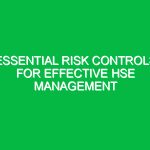Introduction
In the realm of Health, Safety, and Environment (HSE) management, the quest for creating safer workplaces is a paramount concern. At the forefront of this pursuit is the risk assessment tool—a systematic method designed to identify, evaluate, and mitigate potential Hazards. This tool not only helps organizations comply with regulatory requirements but also cultivates a culture of Safety that protects employees, assets, and the environment. Understanding the intricacies of a risk assessment tool is essential for any HSE professional looking to enhance Workplace Safety and compliance.
The significance of a risk assessment tool in the HSE domain cannot be overstated. It serves as the backbone of Safety management systems, transforming theoretical safety principles into practical applications. By utilizing such a tool, organizations can systematically identify Hazards, assess risks, and implement Control Measures. This proactive approach not only minimizes risks but also promotes operational efficiency and Sustainability. Through this article, we will delve deeply into the components, benefits, best practices, and Regulations surrounding risk assessment tools, providing a comprehensive overview to enhance your HSE management strategies.
Key Aspects of Risk Assessment Tools in HSE
Understanding Risk Assessment Tools
At its core, a risk assessment tool is a structured framework that aids in the identification and analysis of risks associated with various activities, processes, or environments. These tools can come in many forms, from spreadsheets and software solutions to standardized checklists and methodologies. The primary goal of a risk assessment tool is to provide a systematic approach to risk management, ensuring that potential hazards are recognized and addressed before they lead to incidents or accidents.
A common feature of risk assessment tools is their ability to categorize risks based on severity and likelihood. For instance, risks can be classified as low, medium, or high, depending on their potential impact on health, safety, and the environment. This classification helps organizations prioritize their response strategies, directing resources towards the most significant risks.
Components of Effective Risk Assessment Tools
An effective risk assessment tool typically encompasses several key components:
- Hazard Identification: This initial step involves recognizing potential hazards that could cause harm. Hazards can be physical (e.g., machinery), chemical (e.g., toxic substances), biological (e.g., pathogens), or ergonomic (e.g., repetitive strain injuries).
- Risk Analysis: After identifying hazards, the next step is to analyze the risks associated with them. This involves evaluating the likelihood of an incident occurring and the potential consequences should it happen.
- Risk Evaluation: In this phase, risks are prioritized based on their severity and likelihood. This evaluation helps organizations determine which risks require immediate action and which can be monitored over time.
- Control Measures: Once risks are evaluated, organizations must implement appropriate Control Measures to mitigate them. These can include engineering controls, administrative Procedures, personal protective equipment (PPE), and Training.
- Monitoring and Review: The final component involves ongoing monitoring of risks and the effectiveness of control measures. Regular reviews ensure that the risk assessment remains relevant and reflects any changes within the workplace.
Benefits of Implementing Risk Assessment Tools
Utilizing a risk assessment tool offers numerous advantages for organizations, including:
- Enhanced Safety: The primary benefit is improved safety for employees and stakeholders. By systematically identifying and addressing hazards, organizations can significantly reduce the likelihood of accidents and injuries.
- Regulatory Compliance: Risk assessment tools help organizations comply with local and international regulations governing health and safety. This compliance can help avoid legal repercussions and financial penalties.
- Cost Savings: Investing in risk assessment can lead to significant cost savings in the long run. Fewer accidents result in reduced medical expenses, lower insurance premiums, and decreased downtime.
- Improved Efficiency: A robust risk management process can streamline operations, as it encourages organizations to eliminate unnecessary risks and optimize their processes.
- Cultural Shift: Implementing risk assessment tools fosters a culture of safety within the organization, encouraging employees to take ownership of their safety and that of their colleagues.
Best Practices for Using Risk Assessment Tools
To maximize the effectiveness of risk assessment tools, organizations should adhere to certain Best Practices:
1. Involve Employees in the Process
Engaging employees in the risk assessment process not only enhances the quality of the assessment but also fosters a sense of ownership among workers. Employees often have insights into potential hazards that may not be apparent to management. By involving them, organizations can ensure that all relevant risks are considered.
2. Use a Structured Approach
Implementing a structured approach, such as the Plan-Do-Check-Act (PDCA) cycle, can enhance the effectiveness of risk assessments. This continuous improvement model encourages organizations to plan their risk assessments, implement control measures, check the results, and act on any identified deficiencies.
3. Regularly Review and Update Assessments
Risks can change over time due to factors such as new equipment, changes in processes, or shifts in regulatory requirements. Regularly reviewing and updating risk assessments ensures that they remain relevant and effective. This proactive approach also helps organizations respond swiftly to emerging risks.
4. Leverage Technology
Modern risk assessment tools often incorporate software solutions that streamline the assessment process. These tools can help automate data collection, analysis, and reporting, making it easier for organizations to track risks and compliance.
5. Provide Training and Resources
Training employees on the importance of risk assessments and how to use the tools effectively is essential. Providing resources, such as manuals or online training modules, can enhance understanding and engagement among staff.
Real-Life Examples and Case Studies
To illustrate the importance of risk assessment tools in practice, consider the following hypothetical scenario:
A manufacturing facility was experiencing a high rate of workplace injuries related to machinery. The management decided to implement a risk assessment tool to identify the root causes of these incidents. Through thorough hazard identification and risk analysis, they discovered that a lack of proper training on machine Operation was a significant factor in the injuries.
By implementing targeted training programs and enhancing machine safety features, the facility significantly reduced its injury rate over the following months. This case highlights how a proactive approach to risk assessment can lead to tangible improvements in Workplace Safety.
Another real-world example comes from the construction industry, where risk assessment tools are essential for managing hazards associated with heavy machinery and working at heights. A large construction firm utilized a comprehensive risk assessment tool to evaluate its job sites, resulting in the identification of several critical hazards. As a result, they adopted additional Safety Measures, including enhanced PPE protocols and regular safety drills, leading to a marked decrease in accidents and near-misses.
Regulations and Standards Governing Risk Assessment Tools
The use of risk assessment tools is not just a best practice but often a regulatory requirement. Various health and safety regulations mandate the implementation of risk assessments in workplaces.
1. Occupational Safety and Health Administration (OSHA)
In the United States, osha requires employers to provide a safe working environment. This includes conducting risk assessments to identify and mitigate hazards. Failure to comply can result in significant fines and legal action.
2. Health and Safety Executive (HSE)
In the UK, the HSE outlines clear guidelines for conducting risk assessments. The Management of Health and Safety at Work Regulations 1999 mandates that employers assess risks and implement appropriate control measures. Non-compliance can lead to prosecutions and penalties.
3. International Standards
ISO 45001 is an international standard for Occupational Health and safety management systems. It emphasizes the need for risk assessments as part of an organization’s safety management practices. Compliance with this standard can enhance an organization’s reputation and credibility.
Understanding these regulations not only ensures compliance but also demonstrates a commitment to health and safety within the organization.
Conclusion
The importance of risk assessment tools in promoting health, safety, and environmental sustainability cannot be overstated. These tools provide a systematic approach to identifying and mitigating risks, ultimately leading to safer workplaces and improved organizational performance. By embracing Best Practices, leveraging technology, and complying with relevant regulations, organizations can create a robust risk management framework that protects their most valuable asset— their people.
As we move toward a more safety-conscious future, it is crucial for HSE professionals to continuously refine their risk assessment strategies. By doing so, they not only contribute to a safer work environment but also foster a culture of proactive risk management that Benefits everyone involved. In the ever-evolving landscape of Workplace Safety, a well-implemented risk assessment tool is an indispensable ally.


